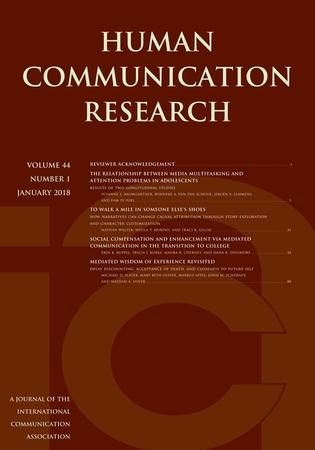Communication Interdependence and Cohabitation: The Role of Interpersonal Technologies in Satisfaction and Disillusionment among Couples in Transition
IF 4.4
1区 文学
Q1 COMMUNICATION
引用次数: 2
Abstract
The transition to cohabitation is a major developmental milestone for romantic couples, yet it is linked to myriad negative outcomes. This study extends the communication interdependence perspective (CIP) to understand the role of technology use in relationship transitions (i.e., the transition to cohabitation). Couples (N = 258 individuals) completed an online survey before and after transitioning to cohabitation to test actor and partner effects of technology integration, segmentation, and difficulty transitioning on relationship satisfaction and ambivalence. Results showed that for actors, constructive integration had positive associations and destructive integration had negative associations with relational outcomes. Difficulty transitioning between channels of communication also had negative implications for relationships. Longitudinal results indicated that negative integration patterns could sometimes buffer against relationship disillusionment. Theoretical implications for the CIP and practical implications for couples are discussed.沟通相互依赖与同居:人际技术在转型期夫妻满意度和幻灭中的作用
向同居过渡是浪漫伴侣发展的一个重要里程碑,但它与无数负面结果有关。本研究扩展了通信相互依存视角(CIP),以理解技术使用在关系转变(即向同居的转变)中的作用。情侣(N = 258人)在过渡到同居前后完成了一项在线调查,以测试技术整合、分割和困难过渡对关系满意度和矛盾心理的演员和伴侣影响。研究结果表明,对于行动者来说,建设性整合与关系结果呈正相关,而破坏性整合则与关系结果负相关。沟通渠道之间的转换困难也对人际关系产生了负面影响。纵向结果表明,负整合模式有时可以缓冲关系的幻灭。讨论了CIP的理论意义和对夫妇的实际意义。
本文章由计算机程序翻译,如有差异,请以英文原文为准。
求助全文
约1分钟内获得全文
求助全文
来源期刊

Human Communication Research
COMMUNICATION-
CiteScore
8.20
自引率
2.00%
发文量
28
期刊介绍:
Human Communication Research is one of the official journals of the prestigious International Communication Association and concentrates on presenting the best empirical work in the area of human communication. It is a top-ranked communication studies journal and one of the top ten journals in the field of human communication. Major topic areas for the journal include language and social interaction, nonverbal communication, interpersonal communication, organizational communication and new technologies, mass communication, health communication, intercultural communication, and developmental issues in communication.
 求助内容:
求助内容: 应助结果提醒方式:
应助结果提醒方式:


